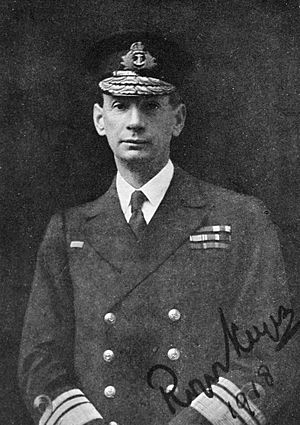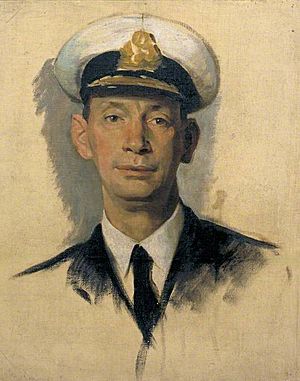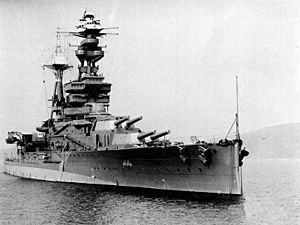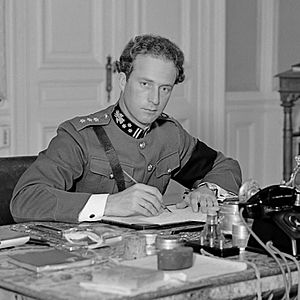Roger Keyes, 1st Baron Keyes facts for kids
Quick facts for kids
The Lord Keyes
|
|
|---|---|

Vice Admiral Sir Roger Keyes, 1918
|
|
| Member of the House of Lords as Baron Keyes |
|
| In office 22 January 1943 – 26 December 1945 |
|
| Preceded by | Peerage created |
| Succeeded by | Roger George Bowlby Keyes |
| Member of Parliament for Portsmouth North |
|
| In office 19 February 1934 – 22 January 1943 |
|
| Preceded by | Sir Bertram Falle |
| Succeeded by | Sir William James |
| Personal details | |
| Born | 4 October 1872 Punjab, British India |
| Died | 26 December 1945 (aged 73) Tingewick, United Kingdom |
| Resting place | St James's Cemetery, Dover |
| Political party | Conservative |
| Relations | Sir Charles Patton Keyes (father) Geoffrey Keyes (son) |
| Military service | |
| Allegiance | United Kingdom |
| Branch/service | Royal Navy |
| Years of service | 1885–1935 1940–1941 |
| Rank | Admiral of the Fleet |
| Commands | HMS Opossum (1898–99) HMS Hart (1899–1900) HMS Fame (1900–01) HMS Bat (1901) HMS Falcon (1902) HMS Sprightly (1902) HMS Venus (1908–10) Commodore-in-Charge, Submarine Service (1912–14) HMS Centurion (1916–17) Dover Patrol (1917–18) Battle Cruiser Force (1919) Battlecruiser Squadron) (1919–21) Atlantic Fleet (1919–21) Commander-in-Chief, Mediterranean Fleet (1925–28) Commander-in-Chief, Portsmouth (1929–31) Director of Combined Operations (1940–41) |
| Battles/wars | Boxer Rebellion First World War Second World War |
| Awards | Knight Grand Cross of the Order of the Bath Knight Commander of the Royal Victorian Order Companion of the Order of St Michael and St George Distinguished Service Order |
Roger John Brownlow Keyes (born October 4, 1872 – died December 26, 1945) was a very important British naval officer. He became an Admiral of the Fleet, which is the highest rank in the Royal Navy.
As a young officer, he helped stop slavery off the coast of Africa. He also played a key role in the Boxer Rebellion in China. During this time, he bravely captured Chinese ships and helped rescue people trapped in Beijing.
In the First World War, Keyes was involved in the Dardanelles Campaign. He later took charge of the Dover Patrol, where he changed tactics and helped sink many German submarines. He also planned and led the famous Zeebrugge Raid, a daring attack on German submarine bases in Belgium.
Between the World Wars, Keyes commanded several important naval fleets. He was elected to Parliament in 1934. During the Second World War, he worked with the King of Belgium. He also became the first leader of Combined Operations, helping to train commandos for special raids.
Contents
Roger Keyes was born in Punjab, British India. His father, Sir Charles Patton Keyes, was a general in the Indian Army. From a young age, Roger knew he wanted to be an Admiral.
He grew up in India and then in the United Kingdom. He joined the Royal Navy as a cadet in 1885. He served on various ships, including HMS Raleigh and HMS Turquoise. On the Turquoise, he helped with missions to stop slavery near Zanzibar.
By 1893, he was a lieutenant. He later commanded the destroyer HMS Opossum in 1898.
Adventures in China

In 1898, Keyes went to China to command the destroyer HMS Hart. He then moved to a newer ship, HMS Fame, in 1899.
In April 1899, he rescued a small British group. They were surrounded by Chinese forces while marking the border of Hong Kong. Keyes led a landing party ashore. While HMS Fame fired, he charged and freed the trapped troops.
In June 1900, during the Boxer Rebellion, Keyes led a bold mission. He captured four Chinese destroyers docked on the Hai River. He and another officer boarded the ships and secured the area.
Soon after, he led a mission to capture a strong fort called Hsi-cheng. He took 32 men, armed with rifles and explosives, on HMS Fame. His team quickly destroyed the Chinese guns and blew up their gunpowder storage.
Keyes was one of the first to climb over the walls of Beijing. He helped break through to the trapped diplomats and free them. For his bravery, he was promoted to commander in November 1900.
Submarine Service and New Roles
After his time in China, Keyes commanded several destroyers. In 1904, he worked in the intelligence section of the British Admiralty. He then became a naval attaché (a military diplomat) in Rome in 1905.
He was promoted to captain in 1905. In 1910, he became the Inspecting Captain of Submarines. By 1912, he was the commodore of the Submarine Service. He encouraged competition in building submarines to make them better. He often went to sea in a destroyer because early submarines had poor visibility.
First World War Heroics

When the First World War began, Keyes commanded the Eighth Submarine Flotilla. He helped plan and took part in the first Battle of Heligoland Bight in August 1914. During this battle, he rescued 220 survivors from a sinking German cruiser.
In February 1915, Keyes became Chief of Staff for the Royal Navy squadron near the Dardanelles. He was deeply involved in the Dardanelles Campaign. He was frustrated when the attack was called off due to low ammunition and fear of mines. He believed they needed to clear the mines to attack the forts.
In March 1915, Keyes led an operation to clear the Kephez minefield. Six trawlers and the cruiser HMS Amethyst tried to clear the mines. However, Turkish artillery heavily attacked his ships. Four trawlers were badly damaged, and HMS Amethyst was hit. After another failed attempt, the naval effort to force the straits was stopped. Troops were landed instead to attack the guns.
For his service in the Dardanelles, Keyes received several awards. He was promoted to rear-admiral in 1917. He then became Director of Plans at the Admiralty.
In January 1918, he took command of the Dover Patrol. Before Keyes, the Dover Patrol had sunk only two German U-boats in two years. Keyes changed their tactics. In the first month after his changes, the Dover Patrol sank five U-boats.
In April 1918, Keyes planned and led the famous Zeebrugge Raid. This was a daring attack on German submarine bases in Zeebrugge and Ostend, Belgium. He was honored for his leadership in these raids.
Between the World Wars

After the war, Keyes commanded the new Battlecruiser Squadron. He flew his flag on the battlecruiser HMS Lion and later on HMS Hood. He was promoted to vice-admiral in 1921.
He became Commander-in-Chief of the Mediterranean Fleet in 1925. He was promoted to full admiral in 1926.
In 1928, there was an incident on the battleship HMS Royal Oak. A Rear Admiral openly criticized a bandmaster and other officers. This led to a big argument that made headlines worldwide. The Admiralty felt Keyes did not handle this situation well.
Keyes became Commander-in-Chief, Portsmouth in 1929. He was promoted to Admiral of the Fleet in 1930. He retired from the Navy in May 1935.
In January 1934, Keyes was elected as a Conservative Member of Parliament for Portsmouth North. In Parliament, he argued for a stronger navy. He was against the Munich Agreement of 1938, which was an agreement with Adolf Hitler.
Second World War Contributions

When the Second World War started, Keyes wanted to serve actively. He believed that taking back Trondheim in Norway was key to winning there. He suggested sending battleships into Trondheim Fjord and landing troops. He even offered to lead the mission himself.
The military leaders agreed with some of his ideas. However, they did not send large warships into the fjord. German destroyers controlled the area, and no airfields were captured for air support. The troops meant for the main attack were never landed.
When the troops were evacuated in May 1940, there was public shock in Britain. Parliament held a debate about Norway. Keyes made a dramatic entrance in his full Admiral of the Fleet uniform. He strongly defended the navy and criticized the government. His speech helped lead to the resignation of Prime Minister Neville Chamberlain. Winston Churchill then became prime minister.
When Germany invaded Belgium in May 1940, Churchill appointed Keyes as a liaison officer to King Leopold III. However, after Belgium surrendered, both Leopold and Keyes faced criticism in the British press.
In June 1940, Keyes became the first Director of Combined Operations. He helped create plans for training commandos and for raids on enemy coasts. He had many bold ideas, but some were considered impractical by other military leaders. He left this role in October 1941.
In 1943, he was made a Baron Keyes, which is a type of noble title.
In 1944, Keyes had an eye injury. He then went on a goodwill tour to Canada, Australia, and New Zealand. During a visit to a ship, he suffered from smoke inhalation after a Japanese aircraft attack. He never fully recovered.
Roger Keyes died at his home in Tingewick on December 26, 1945. He was buried in St James's Cemetery in Dover.
Family Life
In 1906, Roger Keyes married Eva Mary Bowlby. They had three daughters and two sons. One of their sons, Geoffrey Keyes, was killed in action in 1941. He was awarded the Victoria Cross after his death for his extreme bravery.
Awards and Honors
Roger Keyes received many awards for his long and distinguished service:
- Knight Grand Cross of the Order of the Bath
- Knight Commander of the Royal Victorian Order
- Companion of the Order of St Michael and St George
- Companion of the Distinguished Service Order
- Mention in Despatches
- Commandeur of the Legion of Honour (France)
- Navy Distinguished Service Medal (United States)
- Grand Cross, Order of Leopold (Belgium)
- Croix de Guerre 1914–1918 (France)
- Order of the Iron Crown, Second Class (Austria-Hungary)
- Order of the Medjidieh, Second Class (Turkey)
- Commander of the Order of St. Maurice and St. Lazarus (Italy)
- Order of the Redeemer, Third Class (Greece)
|
Images for kids




